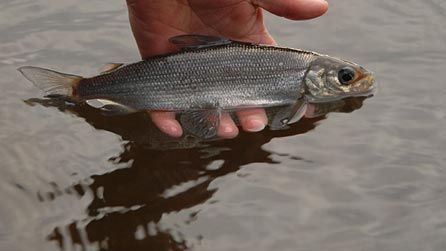
Read the article with FishingTheSpot: the gwyniad fish
Keep an eye on this subject!
Thousands of species spotlights and techniques but also all the local information about your city!



Meet other anglers near you and share your fishing fishing trips, afoot or on a boat, at sea or in freshwater
See the fishing tripsThe Gwyniad fish

Did you fish
this species this month?
The Gwyniad fish belongs to the Salmonidae family. It is a fairly large species: 40 to 60 cm. It reaches 70 cm for 10 kg in the large lakes of northern Europe. Life expectancy would be about ten years. Its breeding period extends quite widely between 15 November and 31 January with a maximum activity between 10 December and 1 January. The female lays 30,000 eggs per kg of weight. This fish is on the IUCN Red List. Fishing is therefore prohibited.
It has the fat fin characteristic of Salmonidae. It has an elongated body, silvery grey, bluish grey, with a more or less brownish back and fairly large scales. The caudal fin is very indented. The mouth is small. Two details that differentiate it from other salmonids. The number of gillospines (here 15 to 70) confirms that they belong to that species. The male has prominent scales on the lateral line, rough to the touch.
The Gwyniad fish lifestyle
It feeds mainly on zooplankton filtered by gillospines, but also on swimming nymphs, chironomids on the surface, but also on insect larvae and small mollusks. It only eats during the day because it captures his prey in plain sight.
The species was recently encountered diving in Neuchâtel (Switzerland), on the shores of the lake in November December, where it spawned in water at a temperature below 7°C. The breeding period lasts about fifteen days. The eggs, deposited on the stony bottoms under 3 to 5 m of water, hatch after 2 to 3 months. This type of spawning in shallow water and in winter would be typical of the species. Males carry nuptial tubers during this period. The Gwyniad of Lake flows up the river that feeds the lake to spawn from mid-December to mid-January. Eggs are laid on gravelly and stony bottoms under 0.5 to 1 meter of water, at a temperature also below 7°C. With a powerful torch you can see them from the road. Eggs are small (2 to 3 mm in diameter) and numerous (30,000 per kg of female). They hatch after 2 to 3 months. Fry and juveniles grow rapidly, and some reach reproductive size by the end of their second year.
The Gwyniad fish habitat
Gregarious, pelagic, this whitefish prefers oligothrophic lakes that are quite large and deep. It likes clear, well oxygenated waters. He travels in groups.
It approaches the bottom of lakes (20 to 25 m) in spring and rises in summer to areas sometimes close to the surface (up to 6 m).
It is found in Lakes in northern Europe, from northeastern France, and northern Asia and America.
The Gwyniad fish angling
This fish is dangerously threatened to disappear. It belongs to the IUCN red list of threatened species. The fishing is therefore prohibited.


